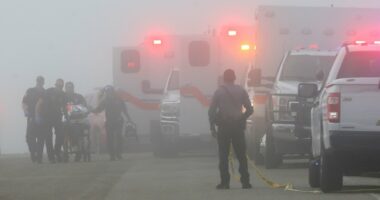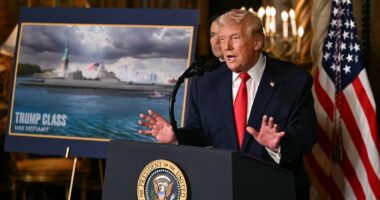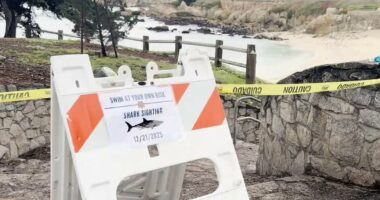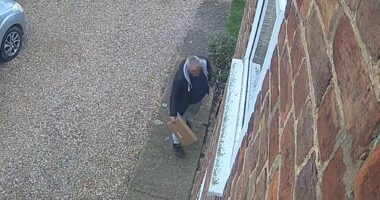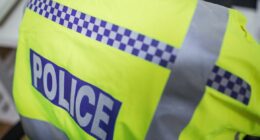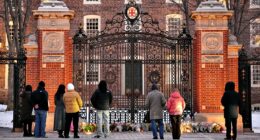Share this @internewscast.com
A couple visiting Waikiki Beach tested positive for the virus after returning to Japan. Public health officials are investigating to see if anyone else was exposed.

HONOLULU — Chantelle Pajarillo had settled into a resort on Hawaii’s famous Waikiki Beach, hoping for a peaceful long weekend away from work and school with her family. The peaceful part came to an end as soon as she turned on the television set Friday night and learned that a Japanese couple who had been staying at the same hotel had fallen ill with the coronavirus.
Ms. Pajarillo, who lives 25 miles away on another part of the island of Oahu, did not know what room the couple had stayed in, but it did not matter: She requested a stash of disinfecting wipes and started cleaning every surface she could find.
“I wiped down everything I knew they would touch: the sliding door, the refrigerator, countertops and the bathroom,” Ms. Pajarillo said on Saturday as she walked back to the pool at the Grand Waikikian, toting a stack of towels. “I’m a germaphobe myself and I have three little kids so I want to make sure I take every precaution.”
Hawaii health officials were working swiftly over the weekend to find anyone who might have had contact with the Japanese couple, who had also visited the island of Maui. Health authorities said the couple, both in their 60s, was not diagnosed until they returned to Japan, but the husband began showing symptoms while still staying in one of Hawaii’s most popular tourist neighborhoods.
More than nine million people visit Hawaii each year, one in three of whom are international tourists. Health officials said that there was little chance that the infection had spread, but that they would continue to search for anyone who had prolonged contact with the couple. There had been no confirmed cases of coronavirus in the state before the two tourists were diagnosed in Japan.
But at least one local resident said he believed that he had spent time with the Japanese man who was later confirmed with the virus. The resident, John Fujiwara, 52, said the friend that he had visited with for about half an hour on Feb. 4 had the same travel itinerary as the man described by state health officials; he also lives in the same city and is in his 60s. Mr. Fujiwara said he had not been able to reach his friend since he left Hawaii on Feb.
Mr. Fujiwara said his friend had seemed healthy, if a bit tired, when they had met to drink coffee, catch up and exchange chocolates as gifts. The man had spent that morning shopping in Chinatown, and had told Mr. Fujiwara that he planned to attend a Japanese language event at a local grocery store immediately after their visit.
Mr. Fujiwara said that he had reached out to state health officials, and had offered to isolate himself after reading a report about the man in The Honolulu Star-Advertiser.

In an email he shared with The New York Times, a disease intervention specialist with the Hawaii Department of Health did not confirm that Mr. Fujiwara’s friend was the one who had been diagnosed, but told him that he should contact the department if he had any symptoms before Tuesday, which would be two weeks after he saw his friend — the maximum incubation period for coronavirus.
Mr. Fujiwara said, “I plan to go to dinner with my girlfriend tonight, unless things change, specifically because I have it in writing from the State of Hawaii Department of Health to continue my daily routine.”
Janice Okubo, a spokeswoman for the Hawaii Department of Health, said that the man who was confirmed with the virus “is not believed to have had any prolonged, close contact with Hawaii residents,” but that health officials were continuing to investigate.
The Coronavirus Outbreak
- Frequently Asked Questions Updated July 7, 2020
- Is the coronavirus airborne? The coronavirus can stay aloft for hours in tiny droplets in stagnant air, infecting people as they inhale, mounting scientific evidence suggests. This risk is highest in crowded indoor spaces with poor ventilation, and may help explain super-spreading events reported in meatpacking plants, churches and restaurants. It’s unclear how often the virus is spread via these tiny droplets, or aerosols, compared with larger droplets that are expelled when a sick person coughs or sneezes, or transmitted through contact with contaminated surfaces, said Linsey Marr, an aerosol expert at Virginia Tech. Aerosols are released even when a person without symptoms exhales, talks or sings, according to Dr. Marr and more than 200 other experts, who have outlined the evidence in an open letter to the World Health Organization.
- What are the symptoms of coronavirus? Common symptoms include fever, a dry cough, fatigue and difficulty breathing or shortness of breath. Some of these symptoms overlap with those of the flu, making detection difficult, but runny noses and stuffy sinuses are less common. The C.D.C. has also added chills, muscle pain, sore throat, headache and a new loss of the sense of taste or smell as symptoms to look out for. Most people fall ill five to seven days after exposure, but symptoms may appear in as few as two days or as many as 14 days.
- What’s the best material for a mask? Scientists around the country have tried to identify everyday materials that do a good job of filtering microscopic particles. In recent tests, HEPA furnace filters scored high, as did vacuum cleaner bags, fabric similar to flannel pajamas and those of 600-count pillowcases. Other materials tested included layered coffee filters and scarves and bandannas. These scored lower, but still captured a small percentage of particles.
- Is it harder to exercise while wearing a mask? A commentary published this month on the website of the British Journal of Sports Medicine points out that covering your face during exercise “comes with issues of potential breathing restriction and discomfort” and requires “balancing benefits versus possible adverse events.” Masks do alter exercise, says Cedric X. Bryant, the president and chief science officer of the American Council on Exercise, a nonprofit organization that funds exercise research and certifies fitness professionals. “In my personal experience,” he says, “heart rates are higher at the same relative intensity when you wear a mask.” Some people also could experience lightheadedness during familiar workouts while masked, says Len Kravitz, a professor of exercise science at the University of New Mexico.
- I’ve heard about a treatment called dexamethasone. Does it work? The steroid, dexamethasone, is the first treatment shown to reduce mortality in severely ill patients, according to scientists in Britain. The drug appears to reduce inflammation caused by the immune system, protecting the tissues. In the study, dexamethasone reduced deaths of patients on ventilators by one-third, and deaths of patients on oxygen by one-fifth.
- What is pandemic paid leave? The coronavirus emergency relief package gives many American workers paid leave if they need to take time off because of the virus. It gives qualified workers two weeks of paid sick leave if they are ill, quarantined or seeking diagnosis or preventive care for coronavirus, or if they are caring for sick family members. It gives 12 weeks of paid leave to people caring for children whose schools are closed or whose child care provider is unavailable because of the coronavirus. It is the first time the United States has had widespread federally mandated paid leave, and includes people who don’t typically get such benefits, like part-time and gig economy workers. But the measure excludes at least half of private-sector workers, including those at the country’s largest employers, and gives small employers significant leeway to deny leave.
- Does asymptomatic transmission of Covid-19 happen? So far, the evidence seems to show it does. A widely cited paper published in April suggests that people are most infectious about two days before the onset of coronavirus symptoms and estimated that 44 percent of new infections were a result of transmission from people who were not yet showing symptoms. Recently, a top expert at the World Health Organization stated that transmission of the coronavirus by people who did not have symptoms was “very rare,” but she later walked back that statement.
- What’s the risk of catching coronavirus from a surface? Touching contaminated objects and then infecting ourselves with the germs is not typically how the virus spreads. But it can happen. A number of studies of flu, rhinovirus, coronavirus and other microbes have shown that respiratory illnesses, including the new coronavirus, can spread by touching contaminated surfaces, particularly in places like day care centers, offices and hospitals. But a long chain of events has to happen for the disease to spread that way. The best way to protect yourself from coronavirus — whether it’s surface transmission or close human contact — is still social distancing, washing your hands, not touching your face and wearing masks.
- How does blood type influence coronavirus? A study by European scientists is the first to document a strong statistical link between genetic variations and Covid-19, the illness caused by the coronavirus. Having Type A blood was linked to a 50 percent increase in the likelihood that a patient would need to get oxygen or to go on a ventilator, according to the new study.
- How can I protect myself while flying? If air travel is unavoidable, there are some steps you can take to protect yourself. Most important: Wash your hands often, and stop touching your face. If possible, choose a window seat. A study from Emory University found that during flu season, the safest place to sit on a plane is by a window, as people sitting in window seats had less contact with potentially sick people. Disinfect hard surfaces. When you get to your seat and your hands are clean, use disinfecting wipes to clean the hard surfaces at your seat like the head and arm rest, the seatbelt buckle, the remote, screen, seat back pocket and the tray table. If the seat is hard and nonporous or leather or pleather, you can wipe that down, too. (Using wipes on upholstered seats could lead to a wet seat and spreading of germs rather than killing them.)
- What should I do if I feel sick? If you’ve been exposed to the coronavirus or think you have, and have a fever or symptoms like a cough or difficulty breathing, call a doctor. They should give you advice on whether you should be tested, how to get tested, and how to seek medical treatment without potentially infecting or exposing others.
Dr. Sarah Park, the state epidemiologist, said the man had most likely been exposed to the virus before leaving Japan or while traveling to Hawaii. He and his wife, who was also confirmed on Saturday with the virus but did not show symptoms while in Hawaii, arrived on Maui on Jan. 28. The man was also symptom-free in Maui, but after the couple moved to Honolulu, on Oahu, on Feb. 3, he began showing signs of a cold.
A spokeswoman for Hilton Grand Vacations, which runs the hotel and time-share where the couple stayed in Waikiki, said the company was working with health officials. A letter slipped under the door of vacationers’ rooms provided tips on how to keep from getting the virus, washing hands being chief among them.
The man who became ill wore a mask when he was outside and while on the flight back to Japan, officials said, and was diagnosed with pneumonia, and later with coronavirus, after returning to the couple’s home in Nagoya, Japan’s fourth-largest city.
The U.S. Centers for Disease Control and Prevention have said that it may be possible to transmit the virus before showing signs of the illness, but that a person is much more likely to spread it when they have symptoms.
Aubree Gordon, an associate professor of epidemiology at the University of Michigan, said she agreed with Hawaiian health officials that people who had traveled with the man were at greatest risk, though anyone who touched surfaces shortly after he did — such as a faucet or toilet handle — could also be at risk.
“I think we’re going to have a lot of cases like this popping up, where people come into a place and get diagnosed there, or leave and we find out after the fact that they’re sick,” Professor Gordon said.
More than 68,000 people around the world have been infected with the virus and more than 1,650 have died, almost all of them in mainland China, where the outbreak began in the city of Wuhan. In the United States, 15 people have been confirmed with the virus, most of whom have been said to have mild symptoms.
Lorin Eleni Gill reported from Honolulu and Nicholas Bogel-Burroughs from New York. Motoko Rich contributed reporting from Tokyo.

